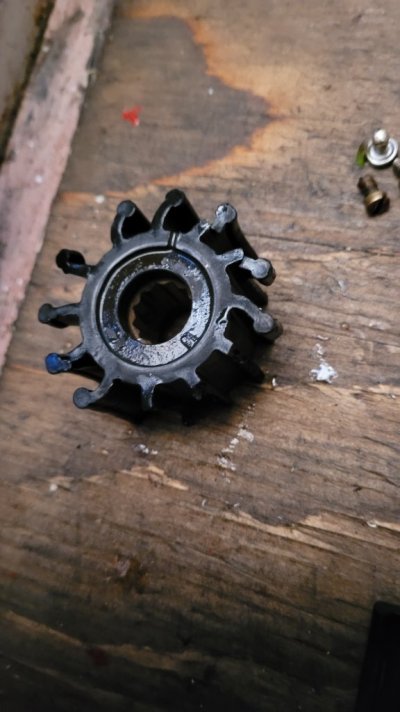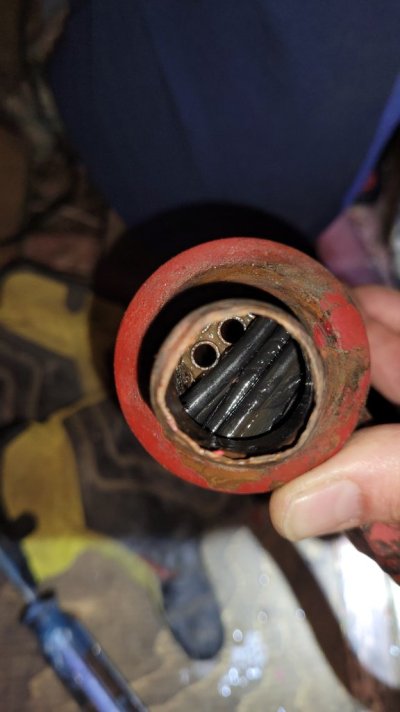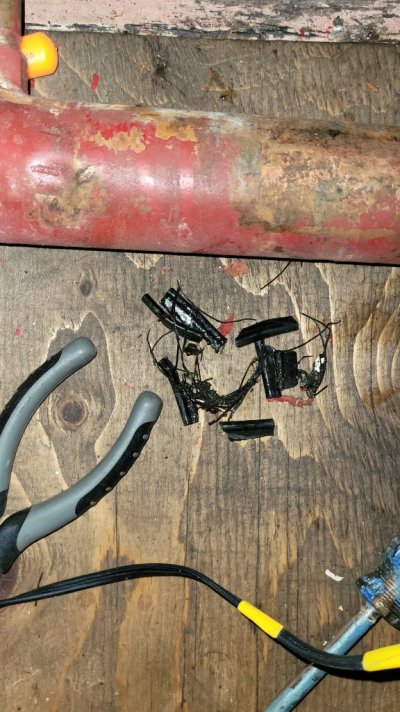You are using an out of date browser. It may not display this or other websites correctly.
You should upgrade or use an alternative browser.
You should upgrade or use an alternative browser.
leahman 120hp no blades on impeller
- Thread starter werpy
- Start date
The friendliest place on the web for anyone who enjoys boating.
If you have answers, please help by responding to the unanswered posts.
If you have answers, please help by responding to the unanswered posts.
RT Firefly
Enigma
Greetings,
Mr. w. Oil cooler will probably trap most pieces but I would check downstream from the cooler as well. IF you clean out the cooler you may be able to sorta piece back the impeller and see what, if anything, is missing.
Mr. w. Oil cooler will probably trap most pieces but I would check downstream from the cooler as well. IF you clean out the cooler you may be able to sorta piece back the impeller and see what, if anything, is missing.
dang was hoping just flow through. got some pieces out but most still missing. im going to try and flush out with wet vac. thank you very much.Greetings,
Mr. w. Oil cooler will probably trap most pieces but I would check downstream from the cooler as well. IF you clean out the cooler you may be able to sorta piece back the impeller and see what, if anything, is missing.
RT Firefly
Enigma
Greetings,
Mr. w. The oil cooler on a Lehman isn't hard to take off. One bolt and a couple of hoses. also give you a good chance to check the cooler itself. Coolers ARE a maintenance item and should be changed on a regular basis (of course I forget the suggested hours) and the coolers are not terribly expensive. Less than $200, I think.
Mr. w. The oil cooler on a Lehman isn't hard to take off. One bolt and a couple of hoses. also give you a good chance to check the cooler itself. Coolers ARE a maintenance item and should be changed on a regular basis (of course I forget the suggested hours) and the coolers are not terribly expensive. Less than $200, I think.
Comodave
Moderator Emeritus
- Joined
- Jul 2, 2015
- Messages
- 21,789
- Location
- Au Gres, MI
- Vessel Name
- Black Dog
- Vessel Make
- Formula 41PC
Put the impeller on a preventative maintenance schedule so this doesn’t happen in the future. I go 2 years on them.
Put the impeller on a preventative maintenance schedule so this doesn’t happen in the future. I go 2 years on them.
thanks . yep live and learn.Put the impeller on a preventative maintenance schedule so this doesn’t happen in the future. I go 2 years on them.
great information. i was thinking it may work. i cant wait to work it over with the vac. thanks again you guysI've had good luck using a wet/dry shop vac to collect impeller pcs. Alternate sucking at pump and blowing from far end of cooler, several times, until no more pcs collected.
rgano
Guru
- Joined
- Oct 8, 2007
- Messages
- 5,080
- Location
- Panama City area
- Vessel Name
- FROLIC
- Vessel Make
- Mainship 30 Pilot II since 2015. GB-42 1986-2015. Former Unlimited Tonnage Master
You should open up the ends of the heat exchanger and take a peek for the pieces as well as to check for general conditions like calcareous buildup (white looking crud). Then think about a flush of the system with a descaling solution. It's not hard at all once you have the setup. Here's my kit

GB36_OuttaHere
Member
In my 135 I was able to pick out about 30 years of impeller bits with a pair of needle nose pilers and harbor freight forceps. I found the first screen about 2" in collected everything. I didn't have to remove the cooler, just the hose between the raw water pump and the heat exchanger.. My impeller was still intact, but I pulled out 16-18 blade bits. Backwashed with a garden hose also.. Good luck..
Max1
Senior Member
- Joined
- Sep 14, 2021
- Messages
- 415
- Vessel Name
- Bermuda Belle
- Vessel Make
- Marine Trader 36 Sedan
I read on here when I first got on the Forum that if you're impeller comes apart, you should always check in the first cooler for bits and pieces. Sure enough when mine did come apart, I checked in my oil cooler Downstream of the impeller pump, and found lots of pieces. Don't even know if all of them were from my impeller or from previous owners as well.. Regardless, I got it all cleaned up, with a big Improvement in consistent engine temperature now.
Attachments
Irish Rambler
Guru
- Joined
- Apr 29, 2014
- Messages
- 1,774
- Location
- FRANCE
- Vessel Name
- 'Snow Mouse.'
- Vessel Make
- BROOM FLYBRIDGE 42.
Wetvacs are a great help but you should put cleaning your heat exchanger on your maintainence schedule. if you've got calcium buildup then buy some 14% strength white vinegar and let the affected parts soak and that will clean them. A good idea once a month is to put a quart of white vinegar down your toilet, pump until just about gone, leave overnight and that will disolve the calcium in your outlet pipe.
- Joined
- May 11, 2019
- Messages
- 3,500
- Location
- United States
- Vessel Name
- Muirgen
- Vessel Make
- 50' Beebe Passagemaker
Another option which I plumbed in to a friends boat was to put a strainer just down stream of the impeller. I told him to change the impeller out every two years, but he didn't, and wouldn't do anything until he started shedding blades and started noticed the engine temps creeping up  . . . . so I installed the strainers, and told him to put visually checking his strainers for part numbers during preflight checks. That he remembered to do. At least it made it easier to find the pieces, but he would have been better off to do the preventive maintenance of changing the impellers every two years . . . .
. . . . so I installed the strainers, and told him to put visually checking his strainers for part numbers during preflight checks. That he remembered to do. At least it made it easier to find the pieces, but he would have been better off to do the preventive maintenance of changing the impellers every two years . . . .
 . . . . so I installed the strainers, and told him to put visually checking his strainers for part numbers during preflight checks. That he remembered to do. At least it made it easier to find the pieces, but he would have been better off to do the preventive maintenance of changing the impellers every two years . . . .
. . . . so I installed the strainers, and told him to put visually checking his strainers for part numbers during preflight checks. That he remembered to do. At least it made it easier to find the pieces, but he would have been better off to do the preventive maintenance of changing the impellers every two years . . . .Similar threads
- Replies
- 7
- Views
- 574
- Replies
- 32
- Views
- 2K



